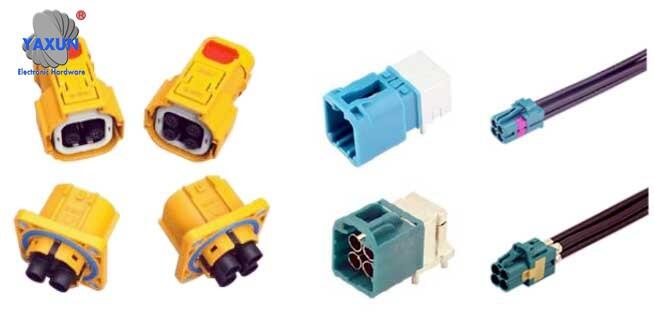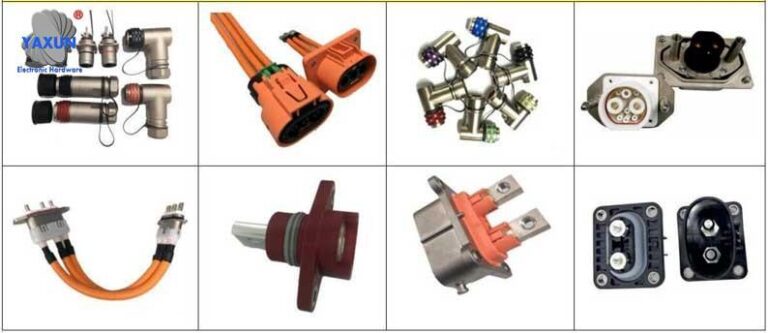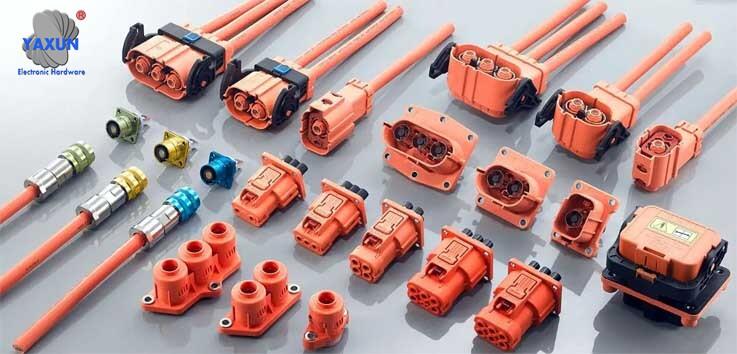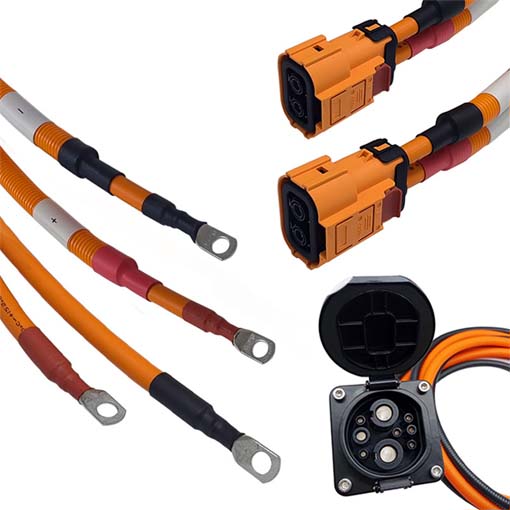Danh mục sản phẩm
Thẻ sản phẩm
Đầu nối năng lượng mới và cáp kết nối
With the rapid development of the new energy vehicle market and the continuous improvement of vehicle intelligence, more and more automotive electrification components are used in new energy vehicles. As the “neural network” of new energy and intelligent systems, the use of vehicle wiring harnesses and connectors has increased significantly. However, due to the limitation of the space in the car and the requirement of light weight of the vehicle, the miniaturization requirement is put forward for the traditional car connector.
With the rapid development of the new energy vehicle market and the continuous improvement of vehicle intelligence, more and more automotive electrification components are used in new energy vehicles. As the “neural network” of new energy and intelligent systems, the use of vehicle wiring harnesses and connectors has increased significantly. However, due to the limitation of the space in the car and the requirement of light weight of the vehicle, the miniaturization requirement is put forward for the traditional car connector.
The demand for miniaturized automotive connectors and supporting thinner wire harnesses can be traced back to the 1980s, and has continued to improve under the trend of vehicle lightweight. In the original distributed ECU architecture, because the ECUs are distributed in different locations and only target a single functional module, in order to connect hundreds of ECUs, it is necessary to use several kilometers of wiring harnesses. The disadvantages of increased vehicle weight and low production automation. However, due to less space constraints, the size of the connector at that time was mainly 1.5mm2 to match the mainstream wire harness size at that time.
How to choose connectors and connecting cables for new energy vehicles?
1) Electrical factors
Current requirements: high current, low current, signal level, determines the type of terminal / size of contact core / plating (0.64mm to 8.0mm pin and male terminal). Steady state, cycle, transient wire size/insulation requirements: voltage drop/corrosion resistance; determines the center distance of the connector.
2) Location/environment
Temperature: engine compartment – sealed, ambient temperature >105°C, vibration, fluid compatibility; passenger compartment – non-sealed, ambient temperature < 85°C, mainly size matters.
Sealing: Potential for high pressure spray/splash; potential for immersion; humidity; type of fluid; for device connectors, is the device sealed
3) tiêu chuẩn
Standards: customer standards; institutional standards; domestic standards; international standards
Connector Performance Test Requirements: Included in system-level specifications. For General Motors, Ford, and Chrysler, generally USCAR regulated engine-related applications have relatively high vibration requirements. Other OEMs generally have their own standards (similar to USCAR). Trend: Equipment-side suppliers are responsible for the performance of mated connectors, and equipment accounts for half of the connector interface mated to the board. Equipment suppliers are required to have a good exchange of information on paired ends
4) Customer Preferences
terminal type
design features
Preferred product strategy: Sourcing-led – need to reduce connector system cost, determined through design competition. Specific application: Ford – Design competition for door connectors. Ford: Preferred terminal design/supplier (focus on contact interface). General Motors: Prefer terminal design (focus on the hole position of the connector). Chrysler: Strategy to favor terminal/plastic parts suppliers
5) Regional preference
Bắc Mỹ: USCAR drawing/performance/design standard Tangless terminal, TPA’s, CPA regulation. In many instances, the harness supplier has a significant influence.
Châu Âu: The design of terminal contact is greatly influenced/developed together with major OEMs, preferring two-piece terminals. Even though cost pressure and North American transplant business force OEMs to consider North American technology and accept Tangled terminals. “Clone” is very common, long-term relationship between OEMs and suppliers.
Châu Á: Traditionally influenced by Toyota. The key to long-term relationship with YAZAKI and SUMITOMO is good quality and trusted relationship. Much focus on assembly capabilities (ergonomics) impacting quality assurance, North America impacting China to change the status quo. Low-cost solutions are the focus.
6) Physical factors
Size, number of loops, location of mating, harness mating or device connection. Mechanical features: levers, bolts, manual mating capability, multi-type connectors for high input/output applications, drawing requirements.

Đầu nối năng lượng mới và cáp kết nối

New energy high voltage connectors and connecting cables

4-core automotive connector harness and sheath

Xe năng lượng mới dây điện cao thế EV
7) Assembly
Harness: connector insertion force visible, audible, tactile operator feedback ergonomic high-speed manual operation reliable guarantee of quality and performance. Implement in-line testing/after-hours processes, TPA’s, CPA’s, maintainability, reduce parts count (period preference).
With the emergence of the “Domain” architecture (Domain) at this stage, the whole vehicle is divided into five functional domains (the division definition of YAXUN company, including the power domain, chassis domain, body domain, cockpit domain, and automatic driving domain). Domain controllers are connected via Ethernet and CAN FD (CAN with Flexible Data Rate). This inevitably leads to dense connections at the domain controller, which in turn creates a shortage of installation space, which further promotes the need for connector miniaturization. Compared with traditional connectors with a size of 1.5mm2, more and more connectors use a size of 0.5mm2, which can accommodate wire harnesses from 0.35mm2 to 0.13mm2. According to the research of a multinational mainstream connector company, this small-sized connector can save up to 50% of the space while meeting the technical requirements.
The use of miniaturized connectors requires the use of thinner wire harnesses. And because of its very small size, it is difficult to use traditional manual installation, and it is necessary to use automated equipment to cut, strip, and crimp the wire harness. Compared with the traditional process, the automated process puts forward higher requirements for the toughness and fracture resistance of the wire harness material.
On the other hand, the application of new energy vehicles needs to meet various harsh environmental requirements, and puts forward extremely high requirements for the connection reliability of wiring harnesses and connectors. Vì thế, when using miniaturized connectors and matching thinner wire harnesses, it is necessary to ensure that their crimping quality can meet the reliability requirements for long-term use. At the same time, connectors and wiring harnesses need to have good electrical conductivity and low heat generation as much as possible, and in extreme environments, there should be no risk of electrochemical corrosion. Vì thế, under comprehensive consideration, the automotive wiring harness using copper cores is still the mainstream technical solution at this stage.
In the future, with the development of technology, the electrical architecture of new energy vehicles will further develop in the direction of cross-domain integration and centralization. Due to the improvement of computing power and the enhancement of functions, the connectors used as input/output terminals will be further miniaturized. Although wireless connection is also a possible development direction, it is more used in non-core low security risk fields such as entertainment. The core automotive electrical field, which is highly related to driving and passenger safety, will still use connectors and wiring harnesses to provide reliable data signals and drive execution. Vì thế, the miniaturization of connectors and the development of wiring harness technology will continue to be one of the important components of the technological progress of new energy vehicles, and will continue to develop and innovate in the future.
Liên hệ chúng tôi
Chờ thư của bạn, chúng tôi sẽ trả lời bạn trong vòng 12 giờ với thông tin có giá trị bạn cần.
 English
English العربية
العربية Български
Български 中文(漢字)
中文(漢字) Čeština
Čeština Dansk
Dansk Eesti keel
Eesti keel Suomi
Suomi Français
Français Deutsch
Deutsch Ελληνικά
Ελληνικά עברית
עברית Magyar
Magyar Bahasa Indonesia
Bahasa Indonesia Italiano
Italiano 日本語
日本語 한국어
한국어 Latīna
Latīna Latviešu valoda
Latviešu valoda Lëtzebuergesch
Lëtzebuergesch Polski
Polski Português
Português Română
Română Русский
Русский Slovenščina
Slovenščina Español
Español Svenska
Svenska ภาษาไทย
ภาษาไทย Tiếng Việt
Tiếng Việt
